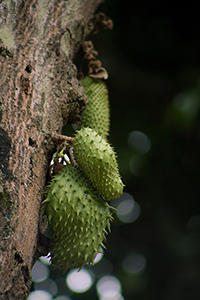Table of Contents
Guanabana benefits come primarily from this tree’s fruit, leaves, and flowers. The fruit can reach a weight of 2 kg and contains a whitish flesh with a pleasant flavor, similar to that of the custard apple, though more acidic. It is highly valued because of its medicinal properties and also as a food.
- ✔ Powerful Naturally Occurring Flavonoids
- ✔ Promotes healthy well being in each person
- ✔ Made from the extract of Soursop (Guanabana) tree – Hecho del extracto de Guanabana

Guanabana Tree Scientific Facts
- Scientific synonym: Annona muricata L.
- Other names: Corossol, soursop bush.
- French: Anone, cachiman epineux.
- Spanish: Guanabano.
- Environment: Native to Mexico and the West Indies, it has spread to tropical areas of America, Africa, and Asia.
- Description: This tree of the Annonaceae family grows from 6 to 8 m high and has a straight trunk and smooth bark. The leaves are large and lanceolate, deep green on the upper side and whitish on the underside. The fruit is large and covered with soft thorns.
- Parts of the plant used medicinally: The fruit, the leaves, and the flowers.
Guanabana Benefits and Healing Properties

The flesh of the guanabana contains easily assimilated sugars, a small number of proteins and fats, vitamins B and C, and mineral salts, especially potassium and phosphorus salts. It has astringent, cholagogue (eases the emptying of the gall bladder), digestive, and vermifuge properties. It is recommended for people suffering from high blood pressure, obesity, heart disorders, and diabetes.
The LEAVES of the guanabana tree are used in infusion as antidiarrheic and digestive. When locally applied in poultice, they have anti-inflammatory properties in the case of mumps.
The FLOWERS have pectoral and febrifuge properties, thus being used as herbal teas in influenza and bronchial catarrh.

How to use Guanabana
- The fruit is taken fresh or as a juice sweetened with honey.
- Infusion of leaves. Prepared with two or three leaves per cup of water. Drink three or four cups daily.
- Infusion of flowers. With one or two flowers per cup of water. Drink three or four cups a day.
- Poultices with mashed leaves are applied below the ear.
Frequently Asked Question
Does guanabana have scientifically verified effects against cancer?
Studies in test tubes and animals show that guanabana extract may affect certain types of cancer cells.
Can guanabana benefits help manage diabetes?
Some animal studies suggest guanabana may help lower blood sugar levels.
Is it true that guanabana is high in antioxidants?
Yes! Guanabana is a good source of antioxidants like vitamin C and other beneficial compounds. Antioxidants combat free radicals that can damage cells and contribute to health issues.
I’ve heard that one of the many benefits of guanabana is that it helps with inflammation. Is this true?
Lab and animal research hints at the anti-inflammatory properties of guanabana.
Is it safe to consume large amounts of guanabana regularly?
Some research links long-term guanabana use with the development of movement disorders similar to Parkinson’s disease. Moderation is essential, and it’s wise to consult a healthcare professional, especially if you have any existing conditions.
Can guanabana boost the immune system?
While guanabana contains vitamin C, which supports immune function, limited direct research exists on its specific immune-boosting effects. The best way to help your immune system is to eat a balanced diet with various fruits and vegetables.
Are there any digestive benefits to consuming guanabana?
Guanabana is a source of fiber that aids digestion and gut health. It may also have antimicrobial properties that could benefit gut flora.
Does guanabana affect blood pressure?
Limited studies suggest guanabana may help lower blood pressure due to its potassium content and potential vasodilating properties. If you take blood pressure medications, you must consult your doctor before consuming significant amounts of guanabana.
Can guanabana help with sleep or anxiety?
Guanabana has been traditionally used for its calming properties.
Are there interactions between guanabana and medications?
Guanabana could interact with certain medications, including those for diabetes and blood pressure. Always consult your doctor before using guanabana if you’re currently taking any medications.
REFERENCES
- George D. Pamplona-Roger, M.D. “Encyclopedia of Medicinal Plants.” George D. Pamplona-Roger, M.D. Encyclopedia of Medicinal Plants. Ed. Francesc X. Gelabert. vols. 2 San Fernando de Henares: Editorial Safeliz, 2000. 489. Print.[guanabana benefits]
- Memorial Sloan Kettering Cancer Center: https://www.mskcc.org/cancer-care/integrative-medicine/herbs/graviola
- Healthline: https://www.healthline.com/nutrition/soursop-benefits
- Tua Saude: https://www.tuasaude.com/en/soursop/
- Medical News Today: https://www.medicalnewstoday.com/articles/319720
Last update on 2024-07-22 / Affiliate links / Images from Amazon Product Advertising API






